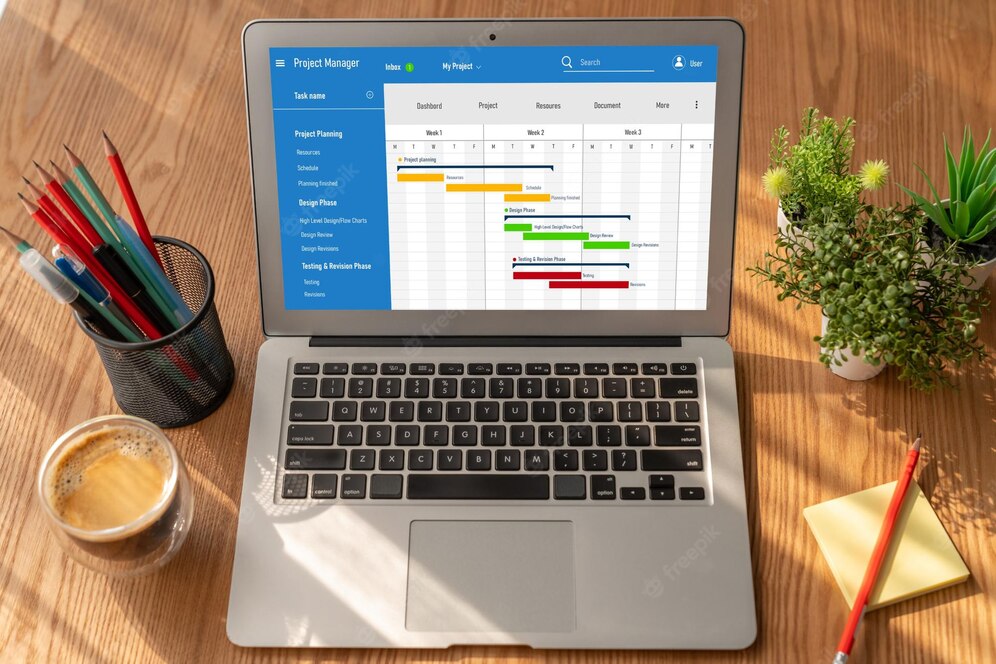A successful business achieves maximum profit with minimum resource investment. Business owners understand that maximizing productivity is the best way to accomplish this goal. Workforce, workplace environment, culture, and routines influence business performance.
This pops the million-dollar question: how to optimize business productivity? Interestingly, some effortless ways promise productivity for a business.
By implementing these strategies, your business and workplace can come around and give you the desired results. So stay with us as we unravel the secret to a productive business.
1: Embrace Technology

We could not stress enough the importance of technology for a successful business. Therefore, it is our top recommended strategy for improving business productivity.
Repetitive tasks consume considerable time. Since they take up most of your productive days, they leave less room for planning business growth strategies.
You do not have to invest time in repetitive or mundane tasks thanks to automated applications and software. Productivity apps manage workload, organize assignments, and track time dedicated to each job. Successful business leaders automate recurring tasks using smart productivity tools so they have more time on their hands to devise the best strategy for their business.
HOW TO DO IT?
- Invest in automation that helps with data entry and employee management.
- Skip manual entries and opt for automated alternatives. Go for computerized, fingerprint-enabled attendance registers.
- Automate your emails.
- Use time tracking software to check the time employees invest in their job.
- Use utility tools for social media management.
- Use engagement apps and project management software to engage your employees and discuss work with team members.
2: Work Smarter, Not Harder

We have heard this quote countless times. However, it relates most to business productivity. Investing your time and making the most of it is the secret to improving business productivity. These include some simple habits and practices that yield extraordinary results.
HOW TO DO IT?
- Take advantage of your peak hours. We all have a time of the day when we feel most productive. Unlike the usual office culture, all humans have their productive times. It is best to start working during those hours for task completion.
- Dedicate your time to the most pressing task. Complete these and move on to the next in line to reduce workload. The satisfaction associated with getting done with an urgent task is the motivation to proceed forward. DO NOT try multitasking. It’s detrimental to your productivity—people who try multitasking end up with no task done and a pile of stuck work.
- A common perception for “getting the job done” is to dedicate yourself completely.
- Taking necessary breaks is essential. Eat when you are hungry. Stretch a bit.
- A tired and preoccupied mind is unproductive. A fresh mind working for four hours is more effective than a distracted mind at work for eight hours. Get to work with a clear head.
- Let go of all distractions while at work. Spend time at work only. Your social media notifications, calls, and messages can wait until you are on a break.
3: Encourage Flexibility

Employees should be managed but not micromanaged. Constant hovering over tasks, strict timings, forced onsite attendance, and tight deadlines are intimidating and suffocating for people and dramatically hampers their capacity to deliver quality. Instead, business leaders can get unexpected output by allowing people to work at their desired times and at their own pace.
HOW TO DO IT?
- Skip the endless meetings to allow employees to focus on the work rather than investing that time in reporting.
- Let your employees complete their jobs as per their priorities. It is essential to understand that you and your employees can differ in executing a particular task at a specific time.
- Set your focus on completed work instead of their sequence.
- Allow employees to work at home as per their schedule, reduce traveling time, and focus entirely on their work instead of surrounding distractions. 53% of employees consider flexible schedules the top quality of their ideal job.
4: Go Remote

Remote and hybrid work setups offer flexibility to employees by allowing them to operate within their comfort zones and work on their own time.
A study concluded that 67% of employees prefer remote work because of its flexibility. Contrary to popular belief, the remote setup has proven far more effective than onsite setups.
HOW TO DO IT?
- Encourage remote work. Maximize productivity by keeping track of tasks through apps and software.
- Encourage your employees to regularly update their work progress in the app instead of in meetings.
5: Environment Matters

A comfortable work environment directly affects talent retention and job satisfaction. When given a choice between a comfortable work environment and financial incentives, employees are likely to choose the former.
The working environment encompasses several physical attributes and policies. Invest in these, and you have the recipe for a booming business.
HOW TO DO IT?
- Make sure your workplace has all amenities for productive work. Provide a comfortable workstation such as a desk, cubicle, or office in a noise-free environment free from unnecessary distractions. Essentially, the workplace must be equipped with necessary facilities such as restrooms, kitchens, and office staff.
- Ensure employees’ relaxation facilities, such as gaming stations, relaxation lounges, etc.
- Effective policies have a significant impact on the work environment.
- Ideally, a preferred working environment will have no bias against any employee, strict rules against sexual or mental harassment, and gender equality.
- Allow Breaks between work. These breaks let employees unwind and start afresh.
- Make all-inclusive policies for leaves. Allow maternity or paternity leaves and other flexible arrangements.
6: Give Power to the People

Everyone loves feeling “important.” People like it when they feel they are in charge of something, and people look up to them to get a job done. By handing over authority to your employees, you evoke a sense of responsibility and accountability, which makes them “want” to do their work effectively instead of “having” to do it.
HOW TO DO IT?
- Discuss tasks while assigning them. In-depth conversations with your employees are the best way to get the job done.
- Take their suggestions into consideration and draft a strategy accordingly.
- Encourage self-accountability. Let your employees take charge and accept responsibility for any shortcomings.
- Allow your employees the freedom to complete tasks in their desired sequence.
- Use a work planner for team members so they can review tasks, complete them as per the set schedule, prioritize urgent jobs, and manage their time.
- Focus on having work done instead of dictating what must be done and when. Indeed, some jobs are a priority. Mention that to your employees.
- Learn to appreciate. Humans love the slightest gesture of acknowledgment.
- Value your employees in their accomplishments. Appreciate first and point out shortcomings later. Follow the sequence of appreciation, guidance, and encouragement.
7: Share and Care

The driving force behind any enterprise is its team members. Happy workers ensure a productive and successful business. Ensuring all tasks are completed on time, and each employee performs their duties well is essential.
However, it is equally important to ensure every employee is happy, satisfied, and emotionally ready for their job. Unsurprisingly, a majority of young employees prefer a workplace with a friendly atmosphere.
HOW TO DO IT?
- Create a pleasant work environment. Allow employees to connect and have open discussions.
- Uphold all employees’ rights regardless of age, gender, ethnicity, or race.
- Create an empathetic environment at work where breakdowns or emotional disturbances are reasons to take a day off or leave early. They are a concern as genuine as having a fever or catching a cold.
- Encourage your employees to reach out to the Human Resources Department in case they have any personal problems.
- The human resource manager should be empathetic and encourage employees’ catharsis and venting their frustrations.
- Hold informal meetings. In a virtual setup, these meetings are a great way for employees to get to know each other and socialize..
8: Plan, Act, Review, Repeat

Back in the day, business tycoons were often seen carrying leather journals and notebooks. These journals held the importance of an oxygen mask, as they had all plans, reminders, tasks, and notes that these business owners consulted often.
Today, these leather-bound journals have been replaced by smartphone apps. However, all successful business leaders still adhere to the habit of planning.
Planning and organizing tasks is a fool-proof strategy for improving business productivity. Task management keeps you and your work organized. It also eliminates the chances of missing something or forgetting it.
Thankfully, there are weekly, monthly, and daily task management applications that help plan work and streamline task completion. Even better, they can add sub-tasks and related jobs, remind you to complete them, and sort them accordingly.
HOW TO DO IT?
- Get your hands on a sophisticated business productivity planner that helps you plan your tasks, prioritize them, and allow you to track your progress.
- Perform and assign your duties according to your planner. Slight deviations are ok, but it is recommended to stick to your planners since they already have your tasks prioritized for you.
- Review your tasks weekly and discuss progress with your team members.
9. Right Person for the Right Job

Appointing professionals and experts in their relevant fields is the most straightforward way to ensure business productivity. In addition, business owners should avoid trying to make employees perform multiple tasks. Doing so hampers task completion and reduces productivity.
HOW TO DO IT?
- For starters, do not try to “adjust” an employee for a job they are not well-versed with.
- Some people have some knowledge of certain software. However, their knowledge is not as vast as a professional in the field.
- Even if you have a multi-talented employee who is an expert in several fields, do not assign multiple tasks to them.
- This can lead to an unmanageable workload, increased work time, and reduced productivity.
- Hire a professional for each task. If you think your task is a one-time job, hire freelancers.
10: Be a Goalkeeper

A set goal is the foundation of a business. Entrepreneurs step into this world to “become the most successful business in the region.” However, to achieve this goal, you must break it down into smaller, achievable, and clear goals.
Short-term goals pave the way for long-term ones. Ideally, always set a SMART goal, i.e., specific, measurable, achievable, relevant, and time-bound.
HOW TO DO IT?
- Specific: make your goals straightforward. Arbitrary goals such as “not having to look at a price tag when buying something” may sound like a goal, but it is more of a motivation.
- Measurable: your goals must have a quantifiable value, either in weight, time, or currency. Increasing sales by 10% is a measurable goal.
- Achievable: make sure you can realistically achieve your goal, depending on a clear and realistic insight into your current business condition. Setting an unachievable goal causes demotivation among business owners.
- Relevant: make sure your goals apply to your business and current strategy.
- If your business is service-based, set a pertinent goal of improving the quality of service.
- Time-bound: this is the most crucial aspect of a goal.
- Setting a target time organizes all processes leading to achieving the goal. Set an achievable time frame within which you expect to see your desired results.
- Review your goals regularly. Track your goal accomplishment progress and know whether you are set in the right direction.
11: Conduct Planned Meetings

You might come across several people who will vigorously advocate against holding meetings. People think meetings are a waste of time and a hindrance to productivity. A productive meeting is critical to an effective business.
However, it is essential to stress the word “productive meeting.” By conducting purposeful, target-oriented meetings, all team members have a recap of all completed jobs.
They can discuss any roadblocks and how to overcome them. They exchange ideas and information for tasks at hand. Meetings help review performances and are great for getting to know each other.
HOW TO DO IT?
- Set clear goals and purpose for the meeting. It supports all members in staying on track and avoiding deviations and drag.
- Keep these meetings short and purposeful.
- If the panel requires a lengthy discussion, keep them between the relevant parties.
- Excuse the rest from attending so they can focus on their work.
- Dedicate a separate meeting for informal talks and lighthearted conversations.
- As important as these are, do not divert to informal discussions during professional sessions.
Conclusion
Every business strives to stay on top of its game. However, improving business productivity is more about lifestyle changes and policy shifts rather than complicated strategies or plans.
Incorporating innovative applications into your routine, introducing effective practices among your employees, and putting technology to good use can maximize your business’ productivity manifolds.
Fortunately, there are software and applications that help keep you organized and help you plan your tasks in order. Week Plan is software that checks all boxes of a one-stop productivity solution for businesses of every scale and industry. Contact today to discover features and plans that suit your business and boost productivity.

More Posts
Product update September 2017
7 Tips for Writing an Effective Meeting Summary
Writing a concise meeting summary is crucial. It ensures that everyone is aware of what happened, even if they missed it. It's extremely important in today's work world, where teams collaborate from different...
AI-Powered Productivity Planning Tools for Enhanced Efficiency
Navigate the world of productivity tools with our productivity planning tools and powerful productivity software. Understand their benefits, identify the best ones, and effortlessly elevate your work efficiency. In today’s market of project...
10 Ways How Anxiety Affects Productivity
Last year, many felt more stressed, depressed, and anxious, says the American Psychological Association. This rise in anxiety impacts how well people work. Amanda Augustine from TopResume notes that work anxiety often comes...